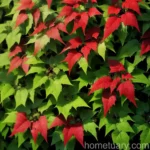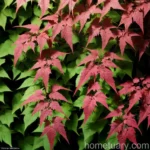Boston Ivy (Parthenocissus tricuspidata): A Comprehensive Plant Guide
Plants are not just vessels of beauty, but they are vital to the health of our planet. They play a crucial role in maintaining the ecological balance and provide numerous benefits to humans and wildlife alike. In this comprehensive guide, we will delve into the wondrous world of Boston Ivy (Parthenocissus tricuspidata). We will explore its culture, uses, care tips, and much more. So, let’s embark on this journey of discovery and unravel the mysteries of this fascinating plant.
What is Boston Ivy (Parthenocissus tricuspidata)?
Boston Ivy, scientifically known as Parthenocissus tricuspidata, is a deciduous, fast-growing vine that hails from East Asia, particularly Japan, Korea, and northern and eastern China. It is a member of the grape family, Vitaceae, and is often confused with English Ivy due to its similar name and growth habit. The plant is renowned for its stunning foliage and its ability to vigorously climb on various structures, providing an aesthetic appeal to buildings, walls, and fences.
Key Takeaways – Boston Ivy (Parthenocissus tricuspidata)
Let’s take a moment to highlight some of the key takeaways about Boston Ivy:
- Scientific Name: Parthenocissus tricuspidata
- Common Name: Boston Ivy
- Family: Vitaceae
- Native Habitat: East Asia
- Type: Deciduous vine
- Growth Rate: Fast-growing
- Uses: Ornamental, shade, privacy screening
- Special Features: Colorful foliage, climbing habit
Now that we have an overview of Boston Ivy, let’s delve into its various aspects to understand how to care for and utilize this remarkable plant.
Culture
Understanding the cultural requirements of Boston Ivy is crucial for its healthy growth and development. From water to sunlight, and fertilizer to soil, each aspect contributes to its overall well-being.
Uses
Boston Ivy serves a multitude of purposes, making it a versatile and valuable addition to any landscape. Some common uses of Boston Ivy include:
- Ornamental Purposes: Adorning walls, buildings, and fences with its lush foliage.
- Shade Provider: Creating natural shade, especially in outdoor spaces.
- Privacy Screening: Acting as a natural barrier for enhanced privacy.
- Aesthetic Value: Adding visual interest and seasonal color to various structures.
- Wildlife Habitat: Providing shelter and food for birds and insects.
The diverse uses of Boston Ivy make it a sought-after plant for both residential and commercial landscapes.
Water
Like most plants, Boston Ivy requires adequate water for optimal growth. However, it is relatively drought-tolerant once established, making it suitable for various climatic conditions. Here are some key points to consider regarding water requirements:
- Establishment Phase: During the initial planting phase, ensure regular watering to help the plant acclimate to its new environment.
- Mature Plant: Once established, Boston Ivy typically thrives in average moisture conditions and can withstand periods of drought.
Proper watering is essential during the first growing season to ensure the plant’s healthy establishment.
Sunlight
Sunlight is a vital factor that influences the growth and performance of Boston Ivy. Understanding its sunlight requirements is crucial for successful cultivation.
- Full Sun: Boston Ivy thrives in full sun to part shade, displaying its best foliage color in full sun.
- Shade Tolerance: It can also tolerate shade, although it may result in less vibrant foliage.
Optimal sunlight exposure is essential for promoting the plant’s vigorous growth and vibrant foliage display.
Fertilizer
Fertilization plays a key role in enhancing the vigor and vitality of Boston Ivy. Proper fertilization practices can contribute to lush foliage and vigorous growth. Consider the following fertilizer guidelines:
- Fertilizer Type: Apply a balanced, slow-release fertilizer specifically formulated for ornamental vines.
- Timing: Fertilize in early spring before new growth begins to support the plant’s seasonal growth.
Applying fertilizer in early spring helps provide the necessary nutrients for Boston Ivy’s robust growth and development.
Soil
Understanding the soil preferences of Boston Ivy is essential for creating an ideal growing environment. It thrives in well-drained, fertile soil with a slightly acidic to neutral pH.
- Well-Drained Soil: Ensure the planting site has good drainage to prevent waterlogging, which can be detrimental to the plant’s health.
- Soil pH: Boston Ivy prefers a slightly acidic to neutral soil pH (6.0-7.5).
Providing suitable soil conditions sets the foundation for healthy growth and the overall well-being of Boston Ivy.
Pruning
Pruning is an essential aspect of Boston Ivy maintenance, aiding in controlling its growth and enhancing its visual appeal. Proper pruning techniques can help manage its growth and maintain a neat and attractive appearance.
- Routine Pruning: Regularly trim back any excessive or unruly growth to maintain the desired shape and size.
- Seasonal Pruning: Perform major pruning in late winter to early spring to remove any dead or damaged vines and encourage new growth.
Pruning is a valuable practice that promotes the health, vigor, and visual appeal of Boston Ivy.
Propagation
Propagating Boston Ivy allows for the expansion of its presence in various locations. Understanding the propagation methods enables individuals to create new plantings and share this remarkable vine with others who appreciate its beauty.
Propagation Methods
- Seeds: Collect ripe seeds and plant them in containers or in outdoor beds to propagate new plants.
- Softwood Cuttings: Take softwood cuttings in late spring or early summer and root them in a suitable growing medium.
By employing these propagation methods, individuals can propagate Boston Ivy and enjoy its charm in additional areas.
Container Popularity
The versatility of Boston Ivy extends to its ability to thrive in containers, making it a popular choice for container gardening and urban landscapes. Its adaptability to container growth expands its potential for beautifying various spaces.
- Outdoor Containers: Boston Ivy can be planted in outdoor containers, adorning patios, balconies, and rooftops with its trailing foliage.
- Indoor Containers: With proper care, it can also be grown indoors, bringing a touch of greenery to interior spaces.
The popularity of Boston Ivy in containers underscores its appeal as a versatile and adaptable plant.
Common Diseases
While Boston Ivy is relatively resistant to diseases and pests, it is essential to be aware of potential issues that may affect its health. By recognizing common diseases and their treatments, individuals can effectively safeguard the plant from any detrimental effects.
Disease Diagnosis
- Powdery Mildew: Characterized by a white, powdery coating on the foliage, powdery mildew can affect Boston Ivy, particularly in humid conditions.
- Leaf Spot: This fungal disease causes dark spots to form on the leaves, potentially leading to leaf drop and reduced plant vigor.
Identifying these common diseases enables individuals to take proactive measures to mitigate their impact and promote the plant’s overall health.
Common Pests
Boston Ivy is generally resistant to pests, but certain insects may pose occasional threats. Being aware of common pests and their control measures can help in effectively managing any infestations.
- Aphids: These small, soft-bodied insects can infest the foliage, leading to distorted growth and honeydew production.
- Scale Insects: Scale insects may infest the stems and leaves, appearing as small, raised bumps. They can cause foliage discoloration and reduced plant vigor.
Vigilance and prompt action are essential in controlling pest infestations and maintaining the plant’s health.
Botanist’s Tips
To further enrich your experience with Boston Ivy, consider these insightful tips from botanists and horticulturists:
- Enhanced Foliage Color: To promote vibrant foliage color, ensure the plant receives ample sunlight, especially during the growing season.
- Support Structures: Provide sturdy support structures such as trellises or fences to accommodate the vigorous climbing habit of Boston Ivy.
- Regular Monitoring: Routinely monitor the plant for any signs of pests or diseases, allowing for timely intervention if needed.
Incorporating these tips into your care routine can contribute to the successful cultivation and maintenance of Boston Ivy.
Fun Facts
Now, let’s uncover some captivating fun facts about Boston Ivy:
- Despite its name, Boston Ivy is not native to Boston, but it acquired the name due to its prevalence in the area.
- The plant’s vibrant foliage transforms into stunning hues of red, orange, and purple during the fall, creating a breathtaking display.
- Boston Ivy is celebrated for its ability to create a natural insulation layer, providing thermal regulation and energy efficiency to buildings.
These intriguing facts add depth to our appreciation of Boston Ivy and its remarkable attributes.
Links to External Resources
For further exploration and valuable insights into Boston Ivy, consider the following links to external resources:
- Boston Ivy: A Versatile Plant for Your Landscape
- Caring for Parthenocissus tricuspidata: Tips and Techniques
- The Role of Parthenocissus tricuspidata in Green Architecture
These external resources offer in-depth guidance and expert advice on cultivating and utilizing Boston Ivy effectively.
Conclusion
Boston Ivy, with its striking foliage and versatile nature, has earned its place as a beloved ornamental plant. From its cultural requirements to its role in landscaping, this plant continues to captivate the hearts of gardening enthusiasts and design aficionados. By understanding the nuances of its care and harnessing its unique attributes, individuals can embrace the beauty and benefits of Boston Ivy in diverse settings. As we conclude our exploration of this remarkable vine, may it inspire a deeper appreciation for the wonders of the natural world and the remarkable plants that enrich our lives.
As this guide comes to an end, take with you the knowledge and inspiration to cultivate and adorn your surroundings with the enchanting presence of Boston Ivy.
By embracing its charm, Boston Ivy can truly transform any space into a breathtaking oasis of natural splendor.
Keywords: Parthenocissus tricuspidata Boston Ivy, Boston Ivy plant guide, Parthenocissus tricuspidata benefits, Boston Ivy care tips, Growing Boston Ivy outdoors, Parthenocissus tricuspidata characteristics, Boston Ivy landscaping ideas, Parthenocissus tricuspidata cultivation, Boston Ivy climber plant, Parthenocissus tricuspidata uses, Boston Ivy maintenance, Parthenocissus tricuspidata varieties, Boston Ivy for shade, Parthenocissus tricuspidata for vertical gardens, Boston Ivy ground cover, Parthenocissus tricuspidata pest control, Boston Ivy pruning techniques, Parthenocissus tricuspidata climbing plant, Boston Ivy seasonal care, Parthenocissus tricuspidata disease prevention, Boston Ivy for privacy, Parthenocissus tricuspidata trellis support, Boston Ivy fast-growing plant, Parthenocissus tricuspidata autumn colors, Boston Ivy winter care, Parthenocissus tricuspidata native habitat, Boston Ivy non-invasive plant, Parthenocissus tricuspidata ground attachment, Boston Ivy container gardening, Parthenocissus tricuspidata wall covering, Boston Ivy for pollinators, Parthenocissus tricuspidata propagating methods, Boston Ivy indoor cultivation, Parthenocissus tricuspidata wildlife benefits, Boston Ivy drought-tolerant plant, Parthenocissus tricuspidata sun requirements, Boston Ivy soil preferences, Parthenocissus tricuspidata self-clinging vine, Boston Ivy habitat suitability, Parthenocissus tricuspidata invasive species control, Boston Ivy companion plants, Parthenocissus tricuspidata medicinal uses, Boston Ivy aesthetic value, Parthenocissus tricuspidata trellis design, Boston Ivy natural fence, Parthenocissus tricuspidata wildlife habitat, Boston Ivy diseases and treatments, Parthenocissus tricuspidata soil amendment, Boston Ivy seasonal pruning, Parthenocissus tricuspidata green architecture















